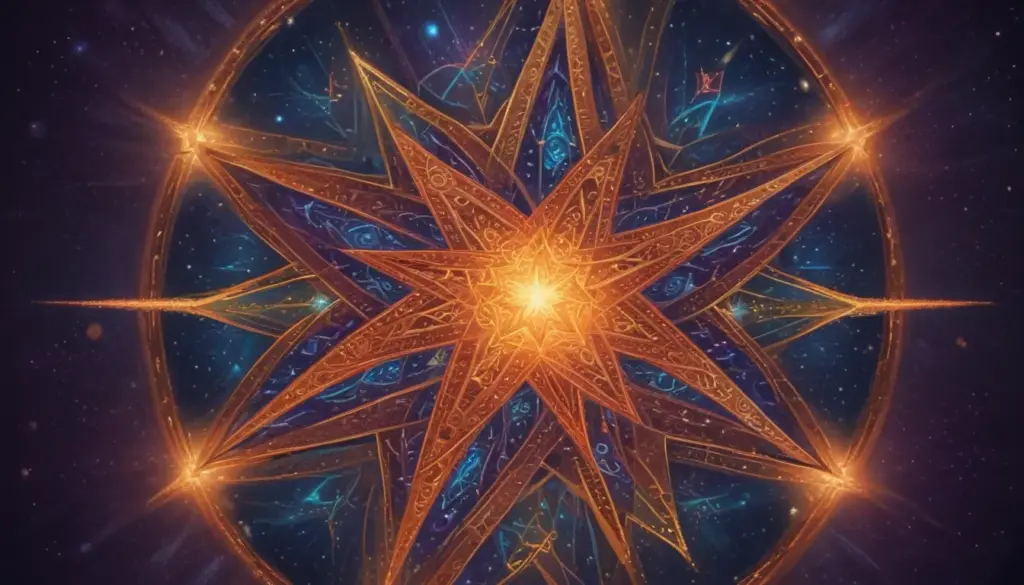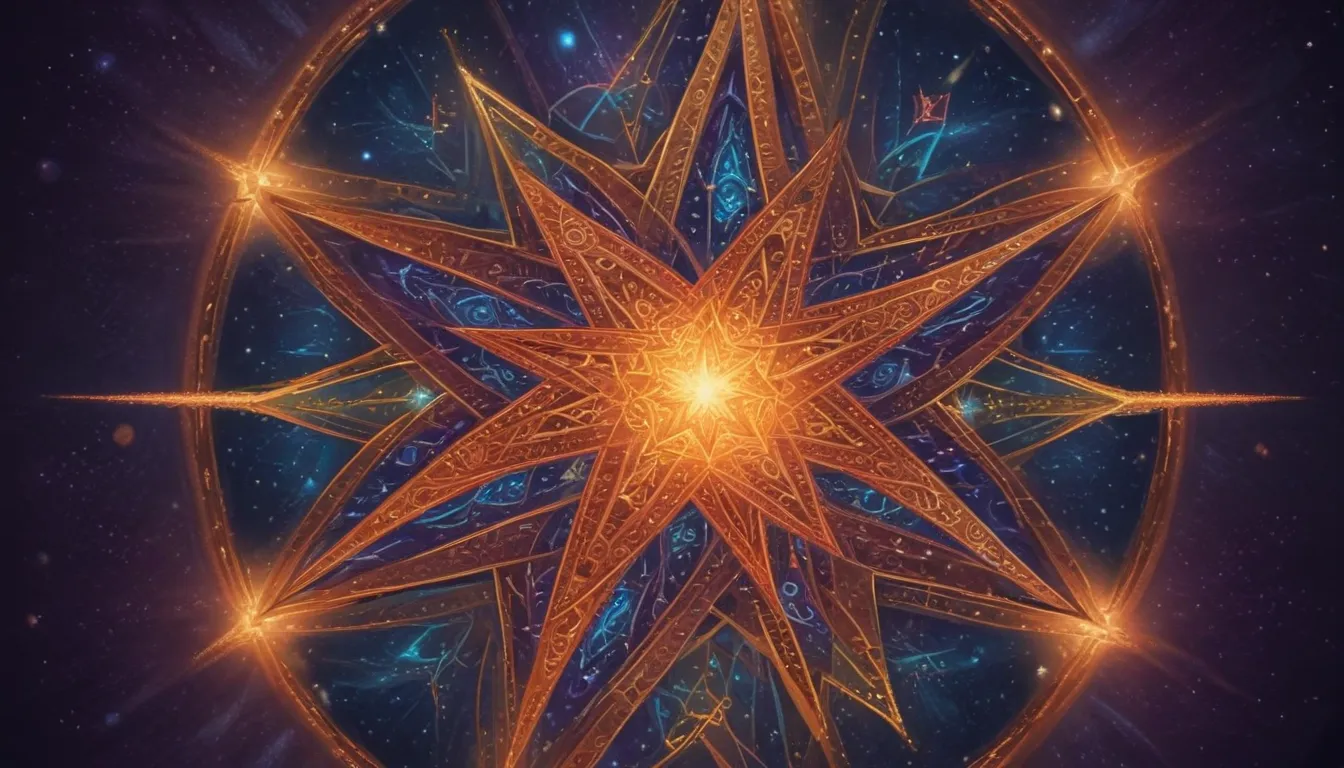
Unlocking the Mystical Significance of the Six-Pointed Star
The six-pointed star, often recognized as the Star of David or hexagram, is far more than a simple geometric shape. It’s a symbol steeped in history, spirituality, and cultural significance, resonating across diverse traditions and belief systems. Understanding what is the significance of a six pointed star requires a journey through ancient texts, philosophical interpretations, and its enduring presence in art and architecture. This comprehensive exploration will delve into the multifaceted meanings of this powerful symbol, offering insights into its historical roots, spiritual interpretations, and cultural impact. We aim to provide a detailed overview of the hexagram, far beyond a simple definition, providing context, history and relevance.
A Journey Through History: Tracing the Six-Pointed Star’s Origins
The exact origins of the six-pointed star are shrouded in some mystery, with its usage predating its association with Judaism. Archaeological evidence suggests its presence in various cultures across the ancient world. The symbol has been discovered on artifacts from ancient India, dating back thousands of years, where it was associated with tantric beliefs. Its presence in these diverse cultures points to a universal appeal and significance that transcends specific religious or cultural boundaries.
Early Appearances and Cultural Diffusion
The hexagram’s appearance in different cultures suggests a gradual diffusion of its symbolism across geographical regions. For instance, it appears in some Roman-era decorations, and alchemical traditions also adopted the symbol, representing the union of opposing forces. Understanding this early diffusion is crucial to appreciating the symbol’s varied interpretations across different societies. This suggests a common understanding of the symbol across different groups of people.
Association with Judaism: The Star of David
While the six-pointed star’s origins are diverse, its most prominent association is with Judaism, where it’s known as the Star of David (Magen David in Hebrew). The association of the six-pointed star with Judaism is not definitively documented until the Middle Ages. It became more widely adopted as a Jewish symbol in the 19th century, eventually finding its place on the flag of Israel in 1948. This relatively recent adoption highlights the evolving nature of symbols and their meanings.
Deciphering the Symbolism: Unveiling the Layers of Meaning
The significance of the six pointed star lies in its intricate symbolism. The hexagram is formed by two overlapping triangles, each carrying its own weight of meaning. These triangles are often interpreted as representing the union of opposing forces or principles, such as male and female, heaven and earth, or spirit and matter. This duality is a central theme in many spiritual and philosophical traditions.
The Interlocking Triangles: A Union of Opposites
One of the most common interpretations of the hexagram is the representation of the union of opposites. The upward-pointing triangle is often associated with male energy, fire, or the spiritual realm, while the downward-pointing triangle represents female energy, water, or the material world. Their intersection symbolizes harmony, balance, and the integration of these seemingly contradictory forces. This interpretation resonates with concepts found in various mystical and philosophical systems.
Microcosm and Macrocosm: Reflecting the Universe
The six-pointed star can also be seen as a representation of the relationship between the microcosm (the individual) and the macrocosm (the universe). The interlocking triangles symbolize the interconnectedness of all things, suggesting that the individual is a reflection of the larger cosmic order. This concept is found in many esoteric traditions, emphasizing the importance of understanding one’s place within the universe.
Divine Protection: A Symbol of Spiritual Shielding
In some traditions, the six-pointed star is viewed as a symbol of divine protection. The interlocking triangles are seen as forming a shield, warding off negative energies and providing spiritual defense. This interpretation is particularly prevalent in Jewish mysticism, where the Star of David is believed to possess protective powers. Some practitioners of magic will use the symbol to protect them from negative entities, or to ward off evil spirits.
The Six-Pointed Star in Different Spiritual Traditions
The hexagram’s presence extends beyond Judaism, finding its place in various other spiritual and esoteric traditions. Its adoption by different cultures speaks to its universal appeal and the profound symbolism it embodies. By examining its role in these diverse contexts, we can gain a deeper understanding of its multifaceted significance.
Alchemy and Hermeticism: The Philosopher’s Stone
In alchemy and Hermeticism, the six-pointed star represents the union of the four elements (earth, air, fire, and water) with the spiritual realms. It is also associated with the Philosopher’s Stone, a legendary substance believed to be capable of transmuting base metals into gold and granting immortality. The hexagram symbolizes the alchemical process of transformation and the integration of opposing forces to achieve a higher state of being. This is often associated with personal growth.
Hinduism and Tantra: The Shatkona
In Hinduism and Tantra, the six-pointed star, known as the Shatkona, is a powerful symbol representing the union of Shiva (male principle) and Shakti (female principle). The upward-pointing triangle represents Shiva, while the downward-pointing triangle represents Shakti. Their intersection symbolizes the creative energy of the universe and the balance between masculine and feminine forces. This symbol is often used in meditation and ritual practices.
Freemasonry: Symbolism and Ritual
Freemasonry, a fraternal organization with roots in the medieval stonemasons’ guilds, incorporates the six-pointed star into its symbolism. While its specific meaning within Freemasonry is complex and multifaceted, it is generally associated with wisdom, knowledge, and the pursuit of enlightenment. The hexagram often appears in Masonic rituals and ceremonies, serving as a reminder of the interconnectedness of all things. The star is often incorporated into their symbols, and is not the only geometric figure that appears. The square and compass also appear.
The Star of David Today: Enduring Symbolism and Modern Relevance
Despite its ancient origins, the six-pointed star continues to hold significance in the modern world. As the central symbol on the flag of Israel, it represents the Jewish people and their connection to their homeland. It also serves as a reminder of the Holocaust and the importance of combating antisemitism. Beyond its political and cultural significance, the Star of David remains a powerful symbol of identity, faith, and hope for many Jews around the world.
Political and Cultural Significance
The Star of David’s prominent presence on the Israeli flag makes it a potent symbol of national identity and sovereignty. However, its association with Zionism and the Israeli-Palestinian conflict has also made it a controversial symbol in some contexts. Understanding the political and cultural implications of the Star of David is essential for navigating discussions about identity, nationalism, and the ongoing conflict in the Middle East.
A Symbol of Identity and Heritage
For many Jews, the Star of David represents their connection to their heritage, culture, and faith. It serves as a visual reminder of their history, traditions, and values. Wearing or displaying the Star of David can be a powerful statement of identity and solidarity with the Jewish community. It is a symbol of belonging and pride, connecting individuals to a rich and ancient history.
Combating Antisemitism: A Symbol of Resilience
Unfortunately, the Star of David has also been used as a symbol of hate and discrimination throughout history. During the Holocaust, Jews were forced to wear yellow stars as a mark of identification and persecution. Today, the Star of David is sometimes used by antisemites to target and harass Jewish individuals and communities. Despite these negative associations, the Star of David remains a symbol of resilience and resistance against antisemitism. It serves as a reminder of the importance of fighting prejudice and discrimination in all its forms.
The Six-Pointed Star in Art and Architecture
The six-pointed star’s aesthetic appeal and symbolic depth have made it a popular motif in art and architecture across various cultures and time periods. Its presence in religious buildings, decorative arts, and graphic design speaks to its enduring power as a visual symbol. From intricate mosaics to modern logos, the hexagram continues to inspire artists and designers around the world.
Religious Buildings and Sacred Spaces
The six-pointed star can be found in various religious buildings, including synagogues, churches, and mosques. Its presence in these sacred spaces suggests its association with spirituality, divinity, and the interconnectedness of all things. The hexagram may be incorporated into stained glass windows, mosaics, or architectural details, adding a layer of symbolic meaning to the building’s design.
Decorative Arts and Jewelry
The six-pointed star is a popular motif in decorative arts and jewelry. Its symmetrical shape and elegant design make it an attractive element for adornment. The hexagram may be incorporated into necklaces, earrings, rings, and other accessories, serving as a personal expression of faith, identity, or spiritual beliefs. The use of different materials and colors can further enhance the symbol’s aesthetic appeal and symbolic meaning.
Modern Design and Branding
The six-pointed star continues to be used in modern design and branding. Its clean lines and geometric simplicity make it a versatile element for creating logos, patterns, and other visual elements. The hexagram can be used to convey a sense of balance, harmony, or interconnectedness, depending on the context and the brand’s message. Its enduring appeal ensures its continued presence in contemporary design.
Expert Perspectives on the Six-Pointed Star’s Enduring Appeal
Leading scholars and experts in symbolism, religious studies, and art history offer valuable insights into the enduring appeal and significance of the six-pointed star. Their perspectives shed light on the symbol’s multifaceted meanings and its continued relevance in the modern world. By examining their research and analysis, we can gain a deeper appreciation for the hexagram’s profound impact on human culture and spirituality.
Scholarly Analysis of Symbolism
Scholars of symbolism emphasize the importance of understanding the historical and cultural context in which symbols are used. They analyze the various interpretations of the six-pointed star across different traditions, highlighting its role as a representation of union, balance, and interconnectedness. Their research provides valuable insights into the symbol’s enduring power and its ability to resonate with people from diverse backgrounds.
Religious Studies and Theological Interpretations
Experts in religious studies examine the theological interpretations of the six-pointed star within different religious traditions. They analyze its role as a symbol of divine protection, spiritual enlightenment, and the relationship between the human and the divine. Their research provides a deeper understanding of the symbol’s religious significance and its impact on the lives of believers.
Art Historical Perspectives on Visual Representation
Art historians analyze the visual representation of the six-pointed star in art and architecture across different time periods and cultures. They examine its use in religious buildings, decorative arts, and modern design, highlighting its aesthetic appeal and its symbolic meaning. Their research provides valuable insights into the symbol’s enduring presence in human visual culture.
A Symbol for the Ages
The six-pointed star, with its rich history and multifaceted symbolism, continues to fascinate and inspire people around the world. From its ancient origins to its modern-day relevance, the hexagram represents a powerful expression of union, balance, and interconnectedness. Whether viewed as a symbol of faith, identity, or spiritual enlightenment, the six-pointed star serves as a reminder of the enduring power of symbols to shape our understanding of the world and our place within it. Share your personal interpretations of the six-pointed star in the comments below, and explore our in-depth guide to sacred geometry for further insights into the world of symbolism.

